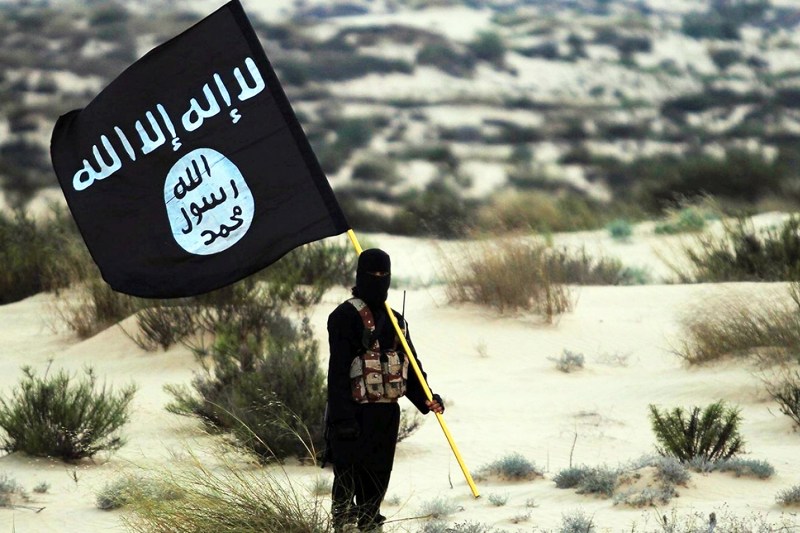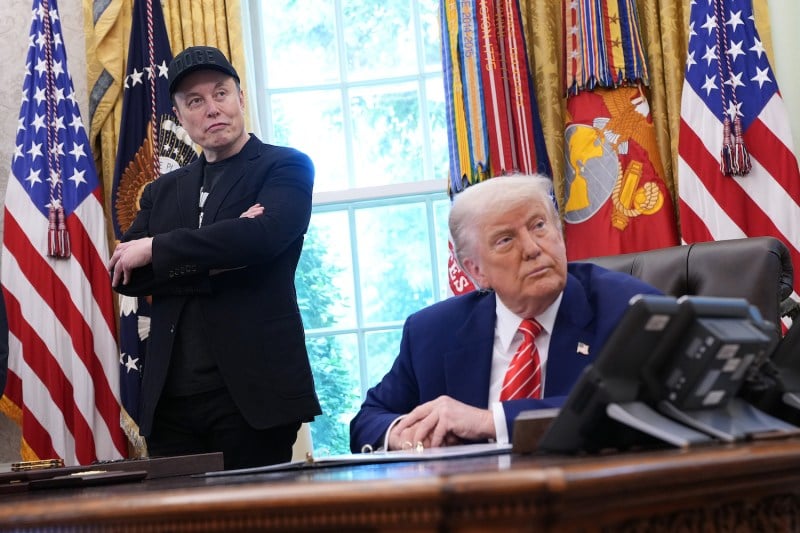The Islamic State Is Making a Comeback

The Islamic State Is Making a Comeback
A metastasizing threat will only remain localized for so long.
In an image released by the group, a masked Islamic State soldier poses holding a banner somewhere in the deserts of Iraq or Syria in 2015. Pictures From History/Universal Images Group via Getty Images
The Defense Department is in the process of drafting plans to withdraw all U.S. troops from Syria after some of President Donald Trump’s recent comments. When asked in late January about withdrawing the remaining U.S. forces from the country, Trump replied, “Syria is its own mess. They got enough messes over there. They don’t need us involved in every one.”
But if the Trump administration does decide to move forward with drawing down the U.S. military footprint in Syria, it will be doing so at a dangerous time. Last year, Islamic State attacks in Syria tripled from the previous year. This increased operational tempo was not just about quantity but sophistication, lethality, and geographic spread of attacks.
The Defense Department is in the process of drafting plans to withdraw all U.S. troops from Syria after some of President Donald Trump’s recent comments. When asked in late January about withdrawing the remaining U.S. forces from the country, Trump replied, “Syria is its own mess. They got enough messes over there. They don’t need us involved in every one.”
But if the Trump administration does decide to move forward with drawing down the U.S. military footprint in Syria, it will be doing so at a dangerous time. Last year, Islamic State attacks in Syria tripled from the previous year. This increased operational tempo was not just about quantity but sophistication, lethality, and geographic spread of attacks.
During his first presidency, Trump received high marks for his willingness to take on the Islamic State. Under his watch, the U.S. military—with help from Kurdish armed groups and Iraqi Shiite militias backed by Iran—wiped out the Islamic State in Mosul, recaptured the last piece of Islamic State territory in Syria, and killed the group’s longtime leader, Abu Bakr al-Baghdadi. In August 2020, Trump declared, “We obliterated 100 percent of the ISIS caliphate.”
But nearly five years after that statement, the Islamic State is not only alive and well; it is flourishing in certain parts of the world, taking advantage of key geopolitical events. This, combined with a letup of counterterrorism pressure in a bevy of global hot spots—including regions where Trump is looking to shrink the U.S. military presence—means it is well-positioned to make a roaring comeback this year.
In Syria, the Islamic State is primed for expansion. With the collapse of Bashar al-Assad’s regime and the advent of a new government led by Ahmed al-Sharaa, the former head of Hayat Tahrir al-Sham (HTS), it seems unlikely that the current government will be able to establish a monopoly on the use of force over the entirety of Syria’s sovereign territory. Moreover, as Sharaa grapples with the Herculean task of putting Syria back together, there will likely be elements of his coalition that will not be convinced to trade the bullet for the ballot. Battle-hardened militants from the Caucasus, Balkans, and parts of Central Asia who are uninterested in another governance project in the Levant could seek to join the Islamic State and continue their jihad, either in Syria or in their countries of origin, including China, Tajikistan, or Russia.
The other glaring issue in Syria is the status of the prisons and detention camps holding Islamic State fighters and their families. These installations, guarded by the Kurdish-led Syrian Democratic Forces (SDF), are coming under increasing strain. Most urgently, the SDF has been engaging in battles with the Turkish-backed Syrian National Army (SNA), which is placing stress on the SDF’s manpower. Moreover, with the recent funding freeze across numerous U.S. government agencies and aid programs, the camps in northeastern Syria have come under scrutiny. After Secretary of State Marco Rubio issued a stop-work order on all foreign aid programs recently, the U.S. contractor hired to train and equip local security forces had to cease operations briefly before receiving a temporary waiver that allowed it to continue its mission.
A prison break at a camp like al-Hol, which houses some 39,000 Islamic State fighters and their families, would be a disaster. Not only would it reinforce the ranks of the Islamic State with violent extremists, but it would serve as a propaganda boon for the group. In January 2022, the Islamic State engineered a jailbreak at a prison in Hasakah, Syria. The ensuing battle lasted 10 days, freed several hundred Islamic State militants, and required U.S. and British ground forces and airpower to quell. This has been a cornerstone of the Islamic State’s strategy dating back to 2012-13, when it first initiated what it dubbed the “Breaking the Walls” campaign in prisons across Iraq.
Syria is not the only part of the world where the Islamic State is surging. The group has expanded rapidly throughout sub-Saharan Africa, solidifying control of territory throughout parts of the Sahel, stretching all the way to the Lake Chad Basin. The Islamic State-West Africa Province and the Islamic State-Greater Sahara remain formidable threats, particularly with no state-backed or regional security forces capable of reining these groups in. And in junta-led countries where Russian private military contractors from the Africa Corps (formerly Wagner Group) operate—Burkina Faso, Mali, Niger—mercenaries are operating with a predictably heavy hand, further exacerbating the terrorism issue and driving locals into the arms of jihadis.
Elsewhere on the continent, Islamic State branches in Mozambique and the Democratic Republic of the Congo have been on the offensive recently, and the Islamic State’s Somalia branch functions as a logistical node in the organization’s global network, where it helps administer the General Directorate of Provinces, the connective sinew that facilitates the movement of money, foreign fighters, and institutional knowledge in the form of experienced trainers and military advisors. High-ranking members of the Somalia branch have also played an essential role in restructuring the group’s leadership, tactics, and strategies, according to Islamic State expert Aaron Zelin.
A comprehensive assessment of the threat posed by the Islamic State globally would be incomplete without discussing the intent and capabilities of the Islamic State-Khorasan Province (ISKP), the group’s South Asian branch that operates across Afghanistan and Pakistan. Lately, it has turned its attention and resources to conducting external operations. In 2024 alone, ISKP launched complex terrorist attacks in Dagestan, Iran, Oman, Russia, and Turkey. The group also sought to conduct attacks in Europe, though these plots were foiled, including sophisticated plans to target the Paris Olympics in July and a Taylor Swift concert in Vienna the following month.
In yet another macabre example of how Islamic State propaganda continues to resonate with supporters and recruits in the West, an Islamic State-inspired former U.S. Army member went on a deadly killing spree in New Orleans in the early morning hours of New Year’s Day, using a truck to ram into pedestrians, leaving 14 dead and dozens more injured.
These incidents are a reflection of how ISKP has undergone a vast evolution in terms of expanding its propaganda capabilities since the withdrawal of U.S. troops from Afghanistan in August 2021. Without an aggressive counterterrorism campaign to keep the group off balance, it will continue to expand into new territory overseas and with that produce larger quantities of propaganda celebrating its successes. In so doing, it encourages its followers to commit acts of terrorism and political violence against the Islamic State’s enemies, especially those in the West.
Given the uptick in Islamic State and Islamic State-inspired activity, Trump’s plans to draw down U.S. forces in Syria and the potential for him to follow suit in Somalia drastically increase the sense of urgency for intelligence agencies and security services. For many in the counterterrorism community, the timing could not be worse. In an article last June titled “The Terrorism Warning Lights Are Blinking Red Again,” Graham Allison and Michael J. Morell warned of an “uncomfortable but unavoidable conclusion”—specifically, “the United States faces a serious threat of a terrorist attack in the months ahead.”
To be sure, the Trump administration is not naive about the nature of the threat. In early February, Trump ordered Navy and Air Force warplanes to launch strikes against Islamic State targets in Somalia. Some see this strike and another against al Qaeda members in Syria as paving the way for a withdrawal of troops from these countries.
In October 2019, following a phone call with Turkish President Recep Tayyip Erdogan, Trump withdrew U.S. troops from Syria. By eliminating high-value targets with airstrikes, the Trump administration may be formulating a case for what is known as an “over the horizon” approach to counterterrorism. But an over-the-horizon approach alone is insufficient, as it places an overreliance on technology as a panacea and neglects the importance of training local forces and building the trappings of a human intelligence network on the ground. A withdrawal of U.S. troops from Syria would cede the counter-Islamic State fight to Ankara. And while the Turks have one of the most capable militaries in the region, their priority has been and will remain fighting against the Kurds in northern Syria—the same entity responsible for guarding the prisons full of Islamic State militants.
In January 2021, Trump withdrew 700 U.S. troops from Somalia. The Biden administration overturned that decision upon taking office and sent troops back to Somalia, where a light U.S. footprint helps train elite Somali special forces known as the Danab. The Danab generates intelligence that feeds into targeting decisions against Islamic State-Somalia fighters and members of the al Qaeda affiliate in the country, al-Shabaab. The latter has recently strengthened its ties to two terrorist groups in Yemen: al Qaeda in the Arabian Peninsula and the Iran-backed Houthis.
Other domestic concerns could hamper the United States’ ongoing fight against the Islamic State. The Trump administration has picked a very public fight with U.S. intelligence agencies, including both the FBI and the CIA. Thousands of agents, operators, and analysts across both organizations are being forced into retirement or redeployed away from counterterrorism missions to focus on illegal immigration and street crime.
After years of winnowing resources reallocated to concentrate on China, Russia, and strategic competition with great-power rivals, further cuts to counterterrorism budgets and manpower, coming at a time of a rising terrorism threat, could spell disaster, leaving the U.S. homeland more vulnerable than ever to a spectacular attack orchestrated by a foreign terrorist organization such as the Islamic State.
Accordingly, the decision to cut the operations of the U.S. Agency for International Development, which fosters economic development and promotes good governance initiatives in fragile states and war-torn regions, is myopic and will ultimately fuel the grievances that terrorists leverage to recruit new members. Islamic State franchises will capitalize on the fallout, as the root causes of violent extremism, including poverty and a widespread lack of justice and accountability, will grow more readily apparent, especially in conflict zones and among populations of refugees and internally displaced people.
While the Trump administration may see a surge in terrorism from West Africa to Southeast Asia as someone else’s problem, the president’s counterterrorism brain trust would be wise to remind him that the 9/11 attacks were planned by a small group of jihadis who enjoyed safe haven in a failed state governed by religious extremists on the other side of the world. There is little doubt that the Islamic State is now paying similarly close attention.
As with several other policy-related areas where the Trump administration is wielding a sledgehammer, it should instead rely on a scalpel. Each incoming administration will have its own set of foreign-policy priorities, and there is nothing unusual about tweaking the U.S. approach to counterterrorism upon taking office. However, things get dangerous when decisions are made based on ideology and not data or evidence. In the case of Trump, his worldview is shaped by a loosely defined “America First” foreign policy, which includes a penchant for quasi-isolationism. Retrenchment from abroad, coupled with gutting the national security bureaucracy, could provide opportunities for terrorist groups to exploit.
While the context is different, the lessons are instructive. Before the deadly Hamas attack on Oct. 7, 2023, the group had closely monitored domestic political turmoil in Israel, tracking regular protests against Prime Minister Benjamin Netanyahu’s government, which Israeli security and intelligence officials publicly complained was negatively impacting military readiness. A similar situation could befall the United States.
The administration would also be well served to avoid unnecessarily triggering violent extremists, as occurred recently when Trump spoke openly about the United States assuming a “long-term ownership” position over the Gaza Strip and suggested that Palestinians would be relocated to Egypt and Jordan. Both Hamas and Palestinian Islamic Jihad reacted to Trump’s comments, vowing never to leave Gaza and to resist any efforts to displace or expel Palestinians. Given the sensitivity of this issue in the Arab and Muslim world, the Islamic State will likely use this as fodder in its regular production of anti-U.S. propaganda.
Trump is only mere weeks into his second term, one in which he has promised to bring “peace through strength.” To keep the homeland safe, he should heed the warnings of a beleaguered counterterrorism community and maintain the status quo. Before making any final decisions to withdraw troops from Syria, Somalia, or other conflict zones where jihadis operated, the Trump administration should conduct a broad-based, comprehensive assessment of terrorist threats facing the country, both the homeland and against Americans and U.S. properties abroad.
That assessment and ongoing consultations with long-standing Five Eyes partners and allies, many of which would be affected by a U.S. troop drawdown, should inform decision-making related to manpower, force posture, and ongoing security cooperation and partner capacity activities in Africa, the Middle East, and elsewhere. In a globalized world of porous borders and transnational connectivity, a metastasizing threat only remains localized for so long.
Colin P. Clarke is the director of research at the Soufan Group and a senior research fellow at the Soufan Center. X: @ColinPClarke
More from Foreign Policy
-

Russian President Vladimir Putin looks on during a press conference after meeting with French President in Moscow, on February 7, 2022. The Domino Theory Is Coming for Putin
A series of setbacks for Russia is only gaining momentum.
-

The container ship Gunde Maersk sits docked at the Port of Oakland on June 24, 2024 in Oakland, California. How Denmark Can Hit Back Against Trump on Greenland
The White House is threatening a close ally with a trade war or worse—but Copenhagen has leverage that could inflict instant pain on the U.S. economy.
-

Donald Trump speaks during an event commemorating the 400th Anniversary of the First Representative Legislative Assembly in Jamestown, Virginia on July 30, 2019. This Could Be ‘Peak Trump’
His return to power has been impressive—but the hard work is about to begin.
-

US Secretary of State Marco Rubio greets employees at the State Department in Washington, DC, on January 21, 2025. The National Security Establishment Needs Working-Class Americans
President Trump has an opportunity to unleash underutilized talent in tackling dangers at home and abroad.










Join the Conversation
Commenting on this and other recent articles is just one benefit of a Foreign Policy subscription.
Already a subscriber?
.
Subscribe
Subscribe
View Comments
Join the Conversation
Join the conversation on this and other recent Foreign Policy articles when you subscribe now.
Subscribe
Subscribe
Not your account?
View Comments
Join the Conversation
Please follow our comment guidelines, stay on topic, and be civil, courteous, and respectful of others’ beliefs.
Change your username |
Log out
Change your username:
CANCEL
Confirm your username to get started.
The default username below has been generated using the first name and last initial on your FP subscriber account. Usernames may be updated at any time and must not contain inappropriate or offensive language.